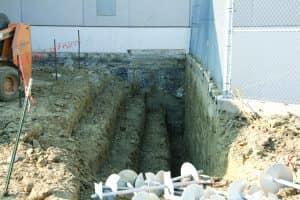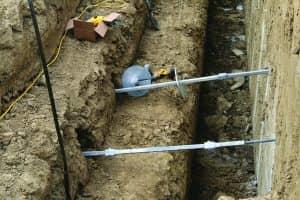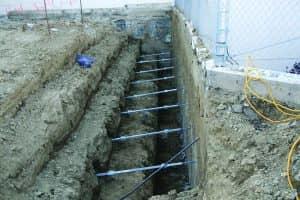Verizon Data Center Addition
Challenge
Thrasher was contracted to assist with an addition for the existing Verizon Data Center building in Omaha, Neb. The addition would be located within the paved area north, east and west of the existing loading docks. An existing concrete retaining wall creates the northern limits of the proposed building area and provides grade separation between the higher elevation paved surface to the south and cooling tanks, piping and equipment to the north, approximately 12 feet lower in elevation.
The west approximate 40 feet of the retaining wall had an obvious bow of approximately six inches at mid-span. With the proposed addition planned above this section of the retaining wall, there was concern that any additional deflection or movement of the wall could affect the new structure planned as close as 18 feet from the wall. The existing 12-inch-thick, reinforced concrete retaining wall supports an unbalanced earth condition of 11 to 12 feet, but actually extends another 13 to 14 feet below the ground surface elevation on the north side of the wall; i.e., total wall height of approximately 25 feet.
The wall was constructed to these depths to locate the wall footings below the then-proposed cooling tanks to be buried below the ground surface on the low side of the wall. Soil borings completed south of the retaining wall identified lean clay fill soils over stiff to very stiff native lean clays. The fill soils extended to depths of 13 to 28 feet and were reasonably compact with dry densities ranging from 99 to 105 pcf, moisture contents of 19 to 25 percent, and hand penetrometer test results generally greater than 6,000 psf.
Solution
Helical tiebacks were selected to stabilize the existing retaining wall prior to construction of the proposed addition. A mini-excavator was used to install the tiebacks and maneuver within the tight spaces on the north side of the wall. The proposed construction scope also included excavation of the backfill soils on the south side of the wall to upgrade the wall's drainage system with free-draining granular material.
With this excavation made, tieback lead sections and extensions could be placed and coupled on the high side of wall, allowing smaller four-inch diameter core holes to be drilled through the wall to minimize cutting of reinforcing steel. Eight Model 150 (1.5-inch solid square shaft) helical tiebacks were installed with 12”-14”-14” helix plate configurations. The tiebacks were positioned six feet down from the top of the wall, spaced at four feet nine inches and installed at a downward angle of ten degrees.
The tiebacks were advanced to the design length of 21 feet behind the wall and to installation torque values correlating to ultimate capacities of at least two times the design working load of 12 kips (FOS≥2). A tube steel waler system was installed to better distribute the tieback forces to the wall. The tiebacks were pre-tensioned following installation.
Need Our Help?
We're proud to be your local experts in deep foundations, concrete lifting, leveling and sealing, and retention systems. Interested in learning more or speaking with one of our solution specialists? Email [email protected] or click here to meet our commercial team.
Agriculture | Building | Healthcare & Education | Manufacturing & Industrial Process Transportation | Utilities & Telecom




